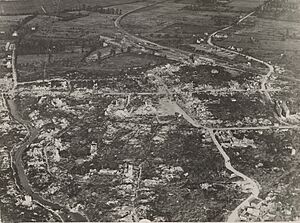Diksmuide facts for kids
Quick facts for kids
Diksmuide
Diksmude (West Flemish)
Dixmude (French)
|
|||
|---|---|---|---|

Town Hall and St Nicholas Church
|
|||
|
|||
| Country | Belgium | ||
| Community | Flemish Community | ||
| Region | Flemish Region | ||
| Province | West Flanders | ||
| Arrondissement | Diksmuide | ||
| Area | |||
| • Total | 149.40 km2 (57.68 sq mi) | ||
| Population
(2018-01-01)Lua error in Module:Wd at line 1575: attempt to index field 'wikibase' (a nil value).
|
|||
| • Total | Lua error in Module:Wd at line 1,575: attempt to index field 'wikibase' (a nil value). | ||
| Postal codes |
8600
|
||
| Area codes | 051 | ||
Diksmuide (pronounced Diks-MOY-duh) is a city and municipality in Belgium. It is located in the Flemish Region of the West Flanders province. The municipality includes the city of Diksmuide itself and several smaller towns. These include Beerst, Esen, Kaaskerke, Keiem, Lampernisse, Leke, Nieuwkapelle, Oostkerke, Oudekapelle, Pervijze, Sint-Jacobs-Kapelle, Stuivekenskerke, Vladslo, and Woumen.
Much of the area west of the city is a polder. This means it is low-lying land protected by dikes and drainage ditches. The main economic activity in the region is dairy farming. They are famous for producing delicious Diksmuide butter.
Contents
History of Diksmuide
Early Days of Diksmuide
Diksmuide began as a Frankish settlement around the 800s. It was first called Dicasmutha. This name comes from Dutch words meaning "dike" and "river mouth". It was located near the River Yser. By the 900s, there was already a chapel and a marketplace.
The city received its official charter (a special document giving it rights) about 200 years later. Defensive walls were built around 1270. The economy back then was mostly based on farming. Dairy products and linen were very important.
From the 1400s until the French Revolution (late 1700s), Diksmuide faced many wars. These wars were between the Netherlands, France, Spain, and Austria. This caused the city to become less active. For example, French forces captured it in 1695. The 1800s were much more peaceful and prosperous for Diksmuide.
Diksmuide in World War I
At the start of World War I in 1914, German troops entered Belgium. They quickly moved towards the North Sea. Their goal was to capture the French ports of Calais and Dunkirk. The Battle of the Yser began in October 1914.
Belgian soldiers used the water to stop the Germans. In late October, they opened floodgates. This flooded the area around the Yser River. The river then became a front line for the rest of the war. Diksmuide was attacked on October 16, 1914. Belgian and French troops defended it bravely. Colonel Alphonse Jacques led the troops who prevented the German Army from taking Diksmuide. Even with many losses, the actions of the soldiers were seen as heroic.
By the end of the fighting, the town was completely destroyed. However, it was fully rebuilt in the 1920s.
Places to See in Diksmuide
- The Belfry is a tall tower with a bell system called a carillon. It has 30 bells! This belfry is a UNESCO World Heritage Site. It is part of the "Belfries of Belgium and France" list.
- The City Hall and the nearby Saint Nicolas Church were totally rebuilt after World War I. They were rebuilt in the Gothic style, like buildings from the 1300s and 1400s.
- The "Trench of Death" (called Dodengang in Dutch) is about 1.5 kilometers from the city center. It is a preserved trench system. Belgian soldiers fought here in very difficult conditions during World War I.
- The Yser Tower is a peace monument. It was first built in the 1920s. It was later taken down in 1946. A new tower was built in the 1950s. This new tower has a World War I museum. It is owned by the United Nations. The Yser Tower is also where the yearly IJzerbedevaart (Pilgrimage of the Yser) takes place. This event celebrates peace and Flemish self-rule.
- Several military cemeteries are located around Diksmuide. The Vladslo German war cemetery is one of them. It is the resting place for over 25,000 German soldiers. It also features the famous sculpture 'Mourning Parents' by Käthe Kollwitz.
Famous People from Diksmuide
- Maria Doolaeghe (1803–1884), a writer.
- Wim Vansevenant, a cyclist who won the "Lanterne rouge" (last place) in the Tour de France three times.
Twin Cities
Diksmuide has friendly connections with these cities:
 Ellesmere, United Kingdom
Ellesmere, United Kingdom Ploemeur, France
Ploemeur, France Rottach-Egern, Germany
Rottach-Egern, Germany Finnentrop, Germany
Finnentrop, Germany
Images for kids
See also
 In Spanish: Dixmuda para niños
In Spanish: Dixmuda para niños








